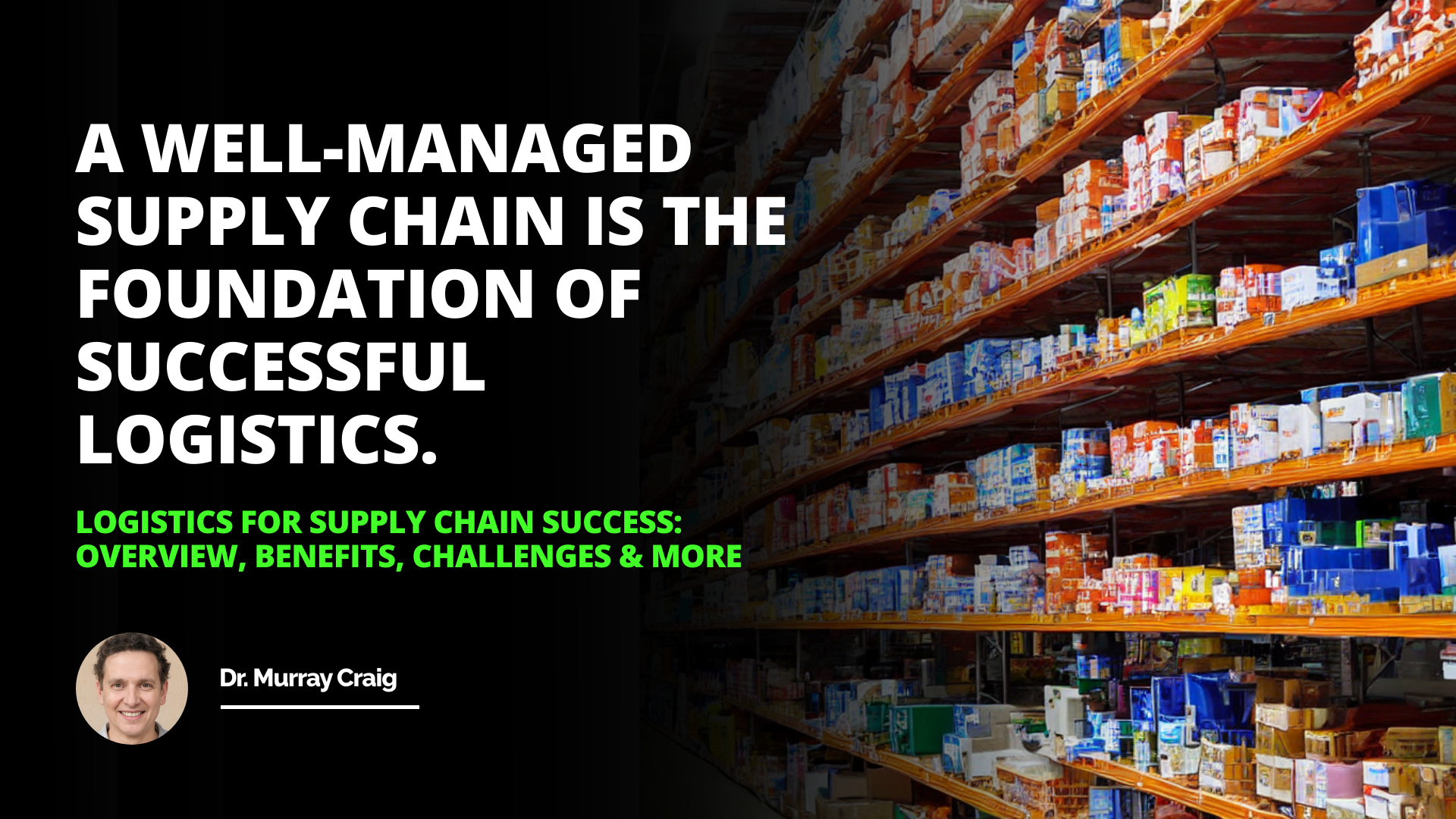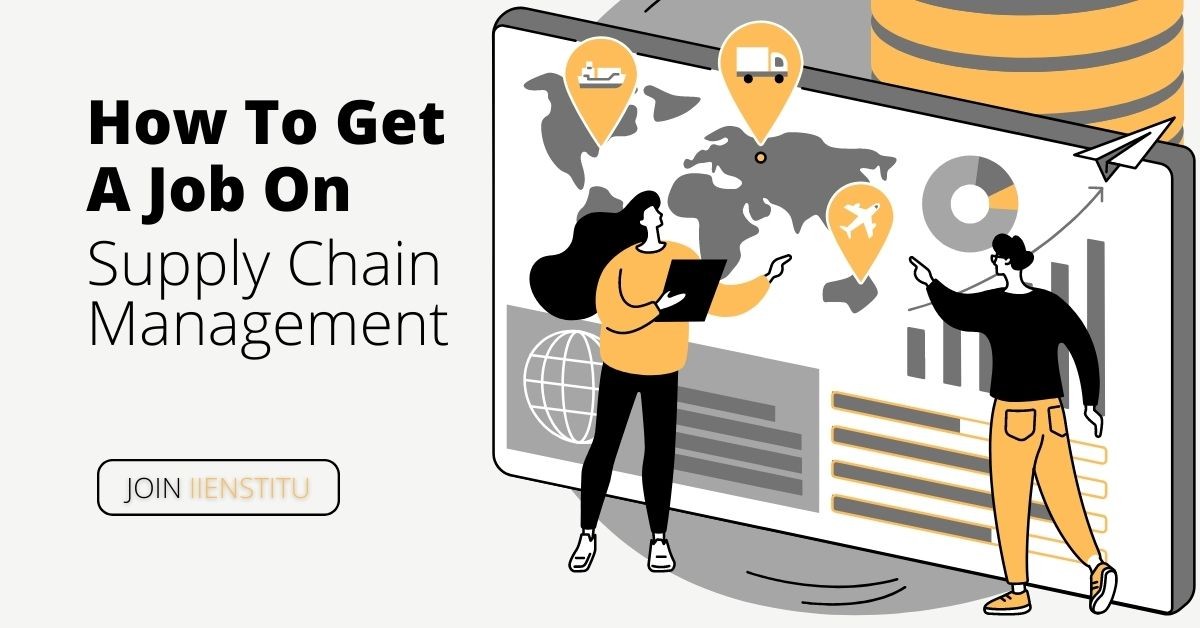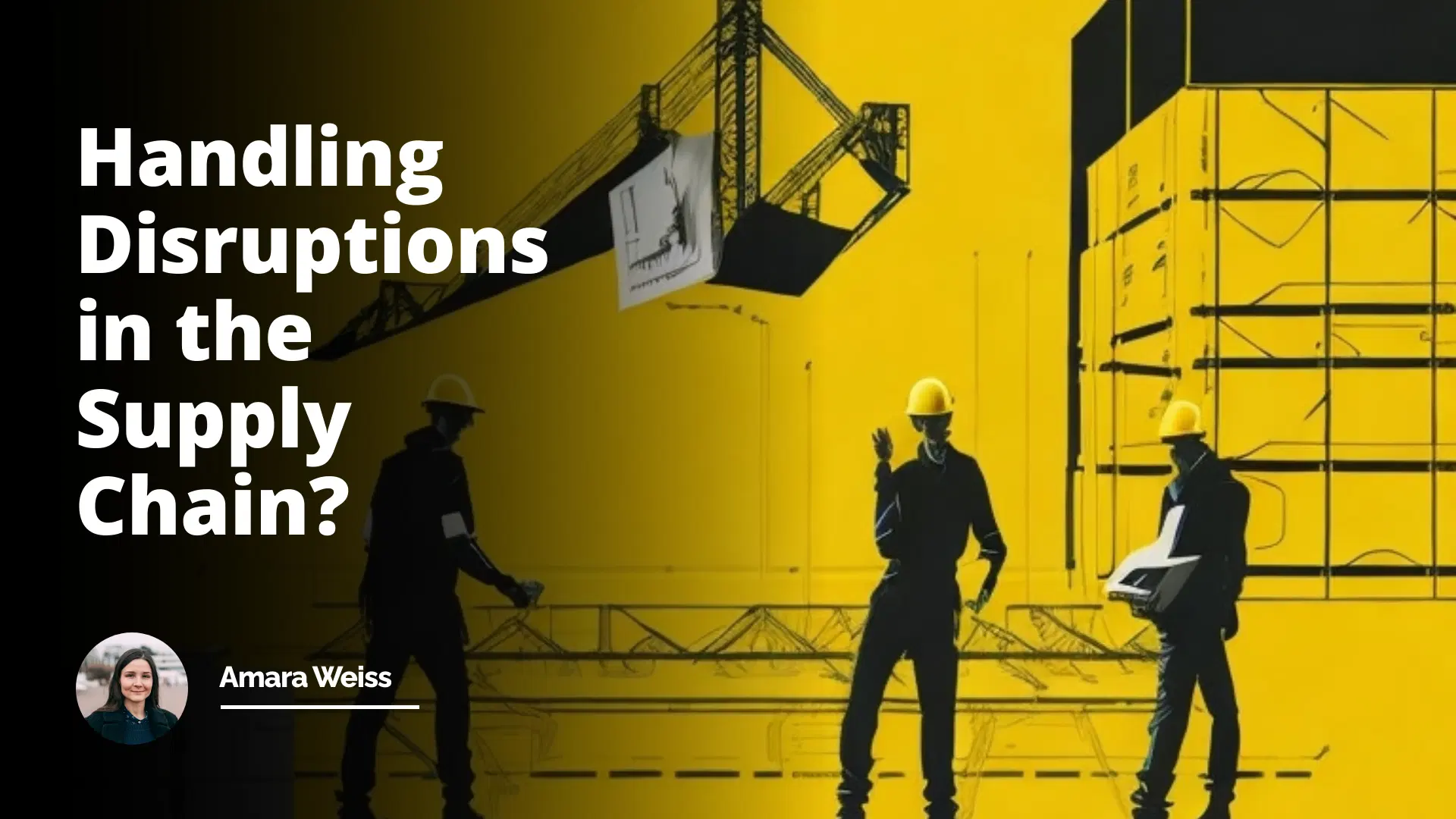
With the escalating complexities of the modern business terrain, the oft-repeated mantra, "handling disruptions in the supply chain," has become more salient than ever. But how well-prepped are you to handle such disruptions in an interview? And why is this question significant? Let’s decipher the clues together.
Why Is the Handling Disruptions in the Supply Chain Question Asked?
In an era dominated by factors such as globalization, digital transformation, and customer-centric strategies, supply chain management has emerged as a quintessential aspect for businesses. Interviewers ask this question to assess an individual's acumen in managing unexpected disruptions and safeguarding the business.
Related course: Supply Chain Management
They want to discern whether you can swim against the tide, strategize adroitly, and keep the supply chain sail smoothly even through a typhoon.
The Purpose of the Question: How to Handle Disruptions in the Supply Chain?
This question is crafted to measure a candidate's knowledge, analytical skills, and decision-making abilities in a crisis. It evaluates your comprehension of supply chain infrastructure, resource mapping, and risk mitigation.
Beyond that, it probes deeper into understanding your capability to employ system thinking, adapt to changes rapidly, envision comprehensive solutions, and orchestrate a robust supply chain.
At What Interview Level Is It Asked?
While typically associated with higher level, management and senior roles in logistics, operations, and procurement, the concept of "handling disruptions in the supply chain" is becoming universal. It can surface in middle-level roles too.
So, irrespective of the job position you’re targeting, be prepared to tackle this question head-on.
What Kind of Answer Is Expected from the Candidate?
When demonstrating your expertise in handling disruptions in the supply chain, interviewers seek well-rounded answers.
Can you interpret the crux of the issue accurately?
Can you come up with resourceful solutions? Are you poised to resolve the crisis promptly?
Can you showcase leadership and strategic decision-making in the face of adversity?
Your answer should reflect an understanding of supply chain dynamics, problem-solving acumen, crisis management skills, and a creative, forward-thinking approach.
Possible Answers to Consider
Here's an outline of how your response might look:
Comprehend the Problem: Start by illustrating a solid understanding of the issue. For example, "Disruptions can arise from numerous sources such as natural disasters, supplier failure, or demand fluctuations. Understanding the root cause is the first step."
Analytical Ability: Next, demonstrate your analytical skills. "In event X at Job Y, I used ABC analysis to identify key vulnerable areas, the surge in demand was impacting our lead times negatively."
Problem-solving Skills: Then, delve into the solution. "I ramped up our inventory for the high-demand products and leveraged our secondary suppliers to bridge the gap."
Related Course: Problem Solving Course
Strategic Approach: Show them your forward-thinking. "To avoid recurrence, I initiated a vendor diversification strategy and created a contingency buffer stock."
Leadership: Lastly, consolidate your answer by summarizing your actions and their impacts.
Related course: Leadership and Management Course
Remember, the essence is in mirroring your capabilities convincingly, backed by factual instances, while talking about handling disruptions in the supply chain.
The supply chain landscape today is strewn with disruptions. However, with ingenuity and agility, you can transform these potential setbacks into opportunities. So, step into your next interview ready to demonstrate how you can turn a supply chain disruption around. After all, chaos creates a ladder, and the one who rises on this ladder is the one next in line for a promotion.
Strategies for Mitigating Supply Chain Disruptions
Case Studies of Effective Disruption Management in Supply Chain
Analysis of Impact and Recovery Time from Different Types of Supply Chain Disruptions
Similar interview questions:
How do you manage disturbances within the supply chain?
What strategies are effective for dealing with supply chain disruptions?
What are some approaches to handle interruptions in the supply chain?
How can a business mitigate the impact of disruptions in the supply chain?
How to tackle issues that disrupt the normal flow in the supply chain?
Can you suggest methods to cope with disruptions in the supply chain?
What proactive measures can be taken to prevent disruptions in the supply chain?
How would you tackle sudden unforeseen disruptions in the supply chain?
What are some practices to manage and smooth out bumps in the supply chain?
How can we ensure stability in the face of supply chain disruptions?

Frequently Asked Questions
1. How do you identify potential risks in your supply chain?
As a supply chain professional, I understand the importance of identifying potential risks in the supply chain. Here are some strategies I use to mitigate these risks:
Conduct Regular Risk Assessments
I believe in being proactive rather than reactive when it comes to supply chain risk management. By conducting regular risk assessments, I can identify potential vulnerabilities before they become major issues. This involves analyzing supplier performance, monitoring market trends, and staying informed about geopolitical events that could impact the supply chain.
Diversify Supplier Base
One effective way to reduce supply chain risk is by diversifying the supplier base. I always advocate for having multiple suppliers for critical components or materials. This way, if one supplier experiences disruptions, we can quickly switch to an alternative source without significant interruptions to our operations.
Implement Robust Contingency Plans
Despite our best efforts, unexpected events can still occur. That's why I prioritize developing robust contingency plans. These plans outline step-by-step actions to take in case of supply chain disruptions, such as natural disasters, labor strikes, or supplier bankruptcies. By having these plans in place, we can minimize the impact of disruptions and ensure business continuity.
Foster Strong Supplier Relationships
In my experience, building strong relationships with suppliers is crucial for effective risk management. Open communication, trust, and collaboration allow us to work together to identify and address potential risks. I make it a point to regularly engage with our key suppliers, share information, and jointly develop risk mitigation strategies.
By implementing these strategies, I have successfully identified and mitigated numerous supply chain risks throughout my career. I am confident that my proactive approach and experience in risk management will enable me to contribute to the resilience and success of your organization's supply chain.
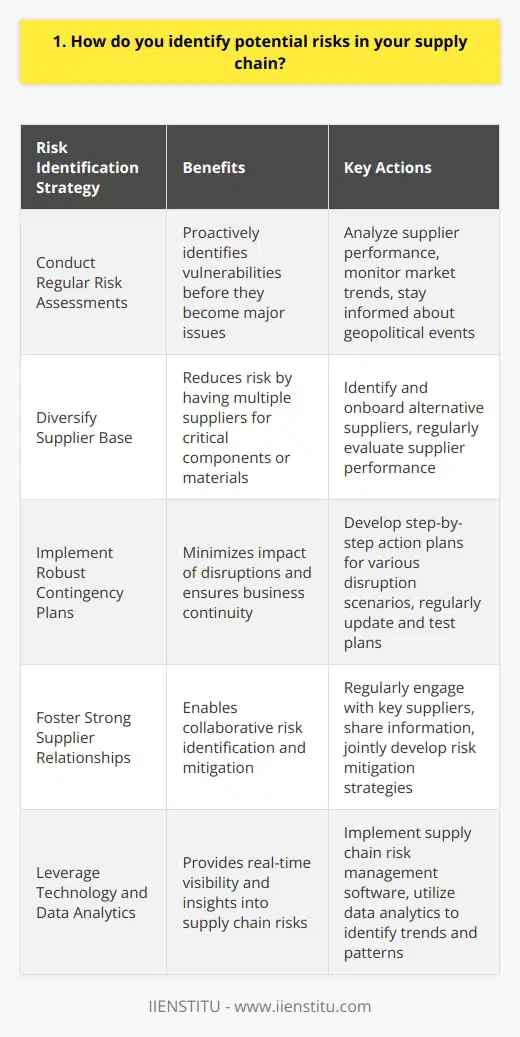
2. What strategies do you employ to mitigate supply chain disruptions?
I employ several strategies to mitigate supply chain disruptions and ensure smooth operations. Firstly, I prioritize building strong relationships with suppliers. By maintaining open communication and fostering trust, I can quickly address any potential issues that arise.
Diversifying Supplier Base
Another key strategy is diversifying our supplier base. I actively seek out multiple reliable suppliers for critical components and materials. This reduces our dependence on any single supplier and provides flexibility in case of disruptions.
Inventory Management
Effective inventory management is crucial. I work closely with our supply chain team to optimize inventory levels. We strike a balance between holding sufficient stock to buffer against disruptions and avoiding excessive inventory costs.
Continuous Monitoring and Risk Assessment
I believe in proactive risk management. I continuously monitor our supply chain for potential vulnerabilities and conduct regular risk assessments. By identifying risks early, we can develop contingency plans and take preventive measures.
Collaboration and Information Sharing
Collaboration is essential in mitigating disruptions. I actively engage with our suppliers, sharing information and insights. We work together to identify potential bottlenecks, develop joint continuity plans, and streamline processes for increased resilience.
Agility and Adaptability
In today's dynamic business environment, agility is key. I foster a culture of adaptability within our supply chain operations. We remain flexible, ready to adjust our strategies and pivot quickly in response to changing circumstances.
By employing these strategies, I strive to build a resilient supply chain that can withstand disruptions. It's an ongoing process of continuous improvement, collaboration, and proactive risk management.
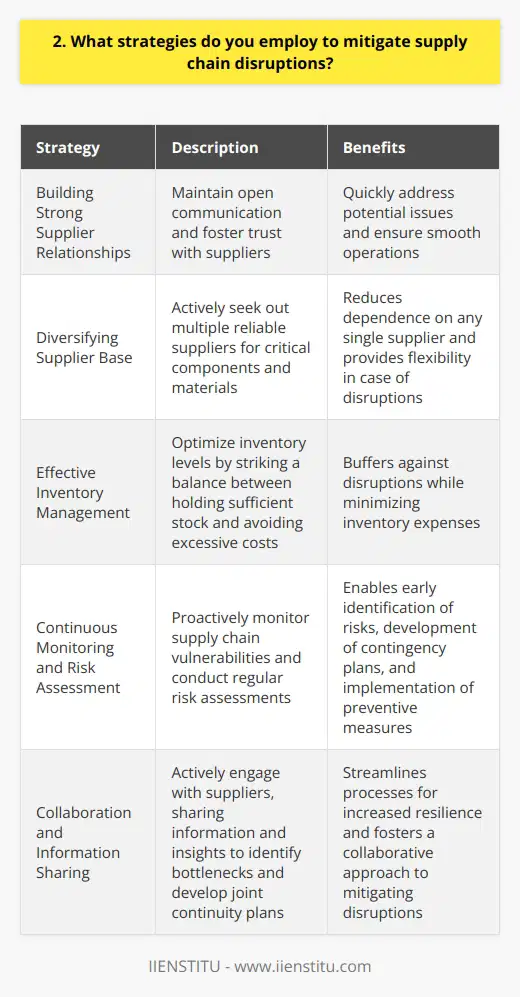
3. How do you ensure effective communication with suppliers during a disruption?
Effective communication with suppliers during disruptions is crucial. I have a few strategies that help me maintain clear lines of communication:
Establish Strong Relationships
I invest time in building strong, trusting relationships with key suppliers. Regular check-ins, even when things are running smoothly, lay the foundation for open dialogue when issues arise. Suppliers who view me as a partner are more responsive and solution-oriented during crises.
Create a Communication Plan
For critical suppliers, I work with them to develop a joint communication plan. This covers emergency contacts, preferred communication channels, expected response times, and escalation procedures. Having this agreed upon in advance streamlines the flow of information when every minute counts.
Leverage Technology
I take advantage of supply chain management software and communication tools. Real-time dashboards and automated alerts keep me apprised of potential disruptions. Video conferencing, instant messaging and collaborative platforms allow for quick coordination with supplier teams, no matter where they're located.
Be Clear and Transparent
In my experience, vague updates create more problems than they solve. When communicating with suppliers about a disruption, I strive to be clear about the issue, the impact, and what I need from them. At the same time, I'm transparent about our side of the situation.
By combining strong relationships, agreed procedures, leveraging technology, and transparent communication, I'm able to effectively collaborate with suppliers to mitigate disruptions. It takes effort, but it pays off in smoother operations and resilient supply chains.
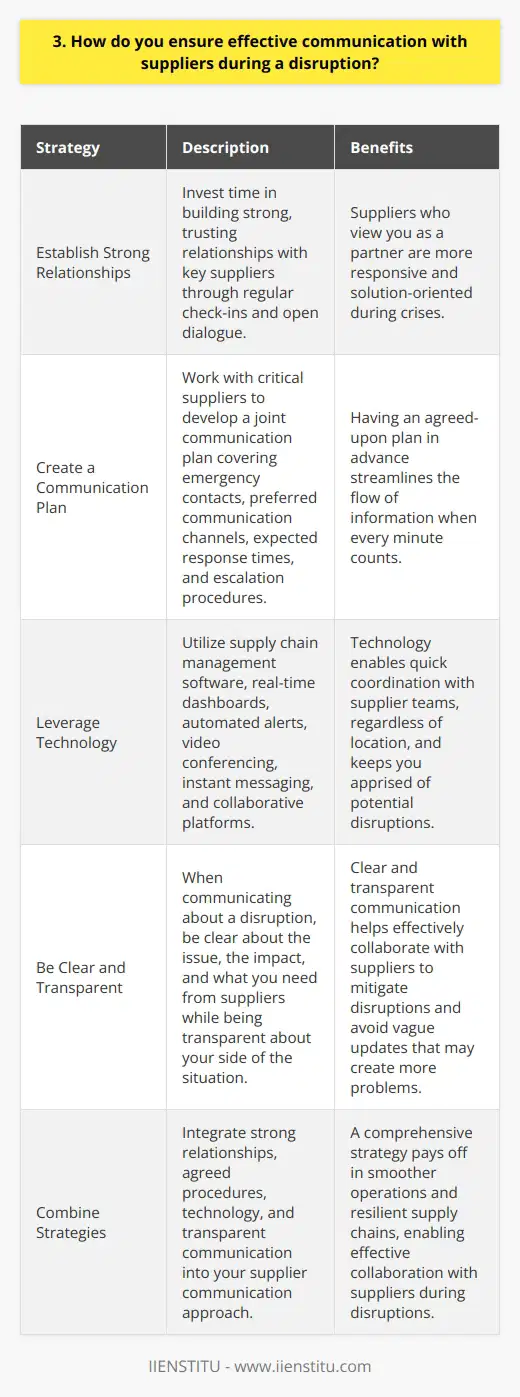
4. What methods do you use to monitor and track supply chain performance?
To effectively monitor and track supply chain performance, I utilize a combination of key performance indicators (KPIs) and analytics tools.
Establishing KPIs
I work closely with stakeholders to identify the most critical KPIs for our supply chain. These may include:
By focusing on these metrics, we can quickly identify areas for improvement and take proactive measures.
Leveraging Analytics Tools
I leverage advanced analytics tools to gain real-time visibility into our supply chain performance. These tools allow us to:
By utilizing these tools, we can make data-driven decisions and respond quickly to any issues that arise.
Collaborating with Suppliers and Partners
I believe in fostering strong relationships with our suppliers and partners. Regular communication and collaboration are key to ensuring:
By working closely with our supply chain partners, we can drive continuous improvement and optimize overall performance.
Continuous Improvement
I am passionate about continuous improvement and always seek ways to optimize our supply chain. This involves:
By embracing a culture of continuous improvement, we can ensure that our supply chain remains agile, efficient, and responsive to changing business needs.

5. How do you prioritize tasks when dealing with multiple supply chain issues simultaneously?
When dealing with multiple supply chain issues simultaneously, I prioritize tasks based on their urgency and impact on the overall operations. I assess which issues pose the greatest risk to customer satisfaction, production efficiency, and financial performance.
Identifying Critical Issues
First, I quickly gather information from relevant stakeholders to identify the most critical issues that need immediate attention. I ask questions to understand the root causes and potential consequences of each problem.
Last year, we faced a shortage of raw materials while dealing with a transportation strike. I prioritized securing alternative suppliers to keep production lines running and prevent costly downtime.
Collaborating with Cross-Functional Teams
Next, I collaborate with cross-functional teams to develop action plans and allocate resources effectively. I believe in leveraging the expertise of colleagues from different departments to find optimal solutions.
During a recent inventory discrepancy crisis, I worked closely with the warehouse and IT teams to investigate the issue. Together, we implemented new inventory tracking procedures to prevent future occurrences.
Monitoring Progress and Adapting
Throughout the process, I closely monitor the progress of each task and adapt my approach as needed. I regularly communicate updates to management and stakeholders to ensure transparency and alignment.
I find that maintaining a calm and focused demeanor helps me navigate complex supply chain challenges. By prioritizing effectively and collaborating with others, I can minimize disruptions and drive positive outcomes for the business.
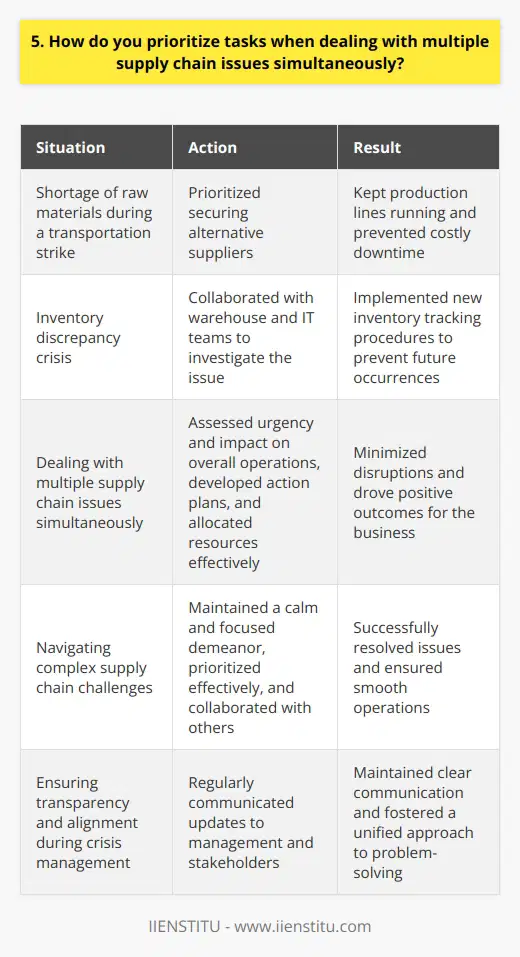
6. What experience do you have in developing contingency plans for supply chain disruptions?
Throughout my career, I've gained significant experience in developing contingency plans for supply chain disruptions. I understand how critical it is to have robust strategies in place to mitigate risks and ensure business continuity.
Identifying Potential Risks
One of the key aspects of my approach is thoroughly analyzing the supply chain to identify potential vulnerabilities. I collaborate closely with cross-functional teams to assess risks such as supplier failures, transportation issues, and natural disasters. By proactively recognizing these risks, we can develop targeted contingency plans.
Building Strong Supplier Relationships
I believe in fostering strong, transparent relationships with suppliers. Regular communication and information sharing help us stay informed about any potential disruptions. I've worked on implementing supplier diversity programs and multi-sourcing strategies to reduce dependency on single suppliers.
Developing Flexible Contingency Plans
When creating contingency plans, I prioritize flexibility and adaptability. I consider alternative suppliers, transportation routes, and inventory management strategies. By having multiple options available, we can quickly pivot in the face of disruptions.
Continuous Monitoring and Improvement
I understand that contingency plans are not set in stone. I regularly review and update them based on changing market conditions and lessons learned from past disruptions. Continuous improvement is essential to staying prepared for future challenges.
Successful Implementation Examples
In my previous role, I successfully implemented a contingency plan that minimized the impact of a major supplier shutdown. By quickly activating alternative suppliers and optimizing inventory levels, we maintained a 95% on-time delivery rate despite the disruption.
I also spearheaded a project to develop a comprehensive risk assessment framework for our supply chain. This allowed us to prioritize risks and allocate resources effectively, resulting in a 30% reduction in supply chain disruptions over a 12-month period.
In summary, I have extensive experience in developing robust contingency plans for supply chain disruptions. By identifying risks, building strong supplier relationships, creating flexible plans, and continuously improving, I can help ensure business continuity and minimize the impact of any disruptions.
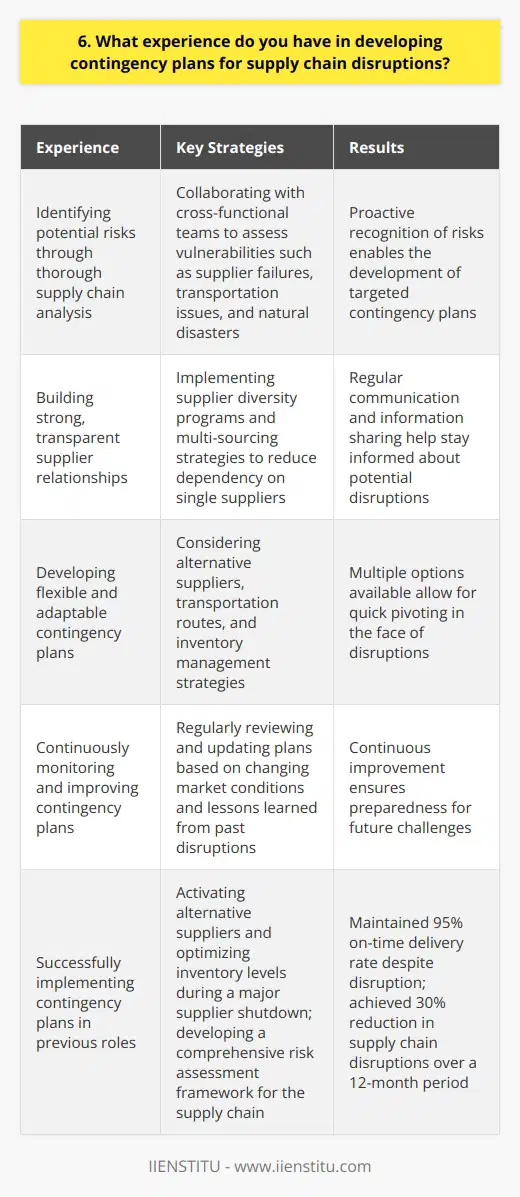
7. How do you assess the impact of a disruption on your company's operations?
When assessing the impact of a disruption on my company's operations, I first gather all available information about the disruption. This includes the nature of the disruption, its severity, and the areas of the company it affects.
Identifying Key Areas of Impact
Next, I identify the key areas of the company that are most likely to be impacted by the disruption. This could include supply chain, production, customer service, or any other critical function. I consider both the immediate and potential long-term effects on these areas.
Assessing the Severity of the Disruption
To determine the severity of the disruption, I look at factors such as the duration of the disruption, the resources required to address it, and the potential financial impact. I also consider any ripple effects the disruption may have on other areas of the company.
Developing a Response Plan
Once I have a clear understanding of the impact of the disruption, I work with my team to develop a response plan. This plan outlines the steps we will take to mitigate the effects of the disruption and keep the company running as smoothly as possible. We prioritize actions based on their potential to minimize damage and speed up recovery.
Communicating with Stakeholders
Throughout the process, I maintain open lines of communication with all relevant stakeholders, including employees, customers, and suppliers. I believe in being transparent about the situation and providing regular updates on our progress. This helps to maintain trust and confidence in the company's ability to weather the storm.
In my experience, the key to effectively assessing and responding to a disruption is to stay calm, gather accurate information, and work collaboratively with your team. By taking a proactive and organized approach, it's possible to minimize the negative impact and keep the company moving forward.
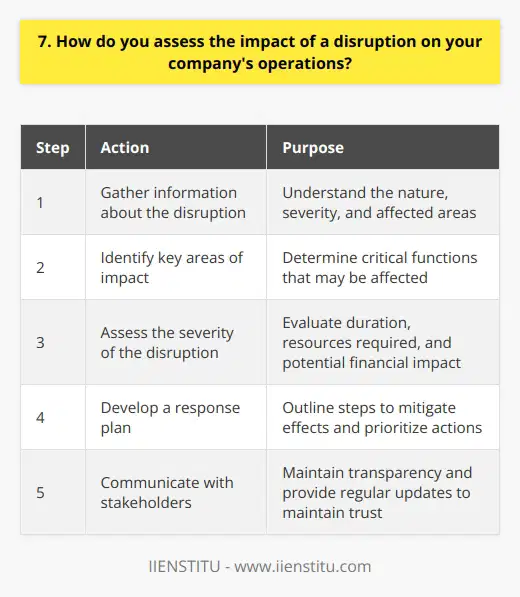
8. What steps do you take to maintain customer satisfaction during supply chain disruptions?
At my previous company, we faced supply chain disruptions due to the pandemic. To maintain customer satisfaction, I took several proactive steps:
Transparent Communication
I believe in being upfront with customers about potential delays. I would personally reach out to affected customers and explain the situation, providing realistic timelines for resolution.
Sourcing Alternative Suppliers
Whenever possible, I worked with our procurement team to identify backup suppliers. This allowed us to fulfill orders, even if our primary suppliers were experiencing issues.
Prioritizing Critical Orders
During disruptions, I collaborated with sales and operations to prioritize orders based on urgency and customer needs. We aimed to minimize the impact on our most important clients.
Offering Substitutions or Discounts
In cases where delays were unavoidable, I proposed suitable product substitutions to customers. If no alternatives were available, I would offer discounts or other incentives as a goodwill gesture.
Continuous Updates
Throughout the disruption, I kept customers informed with regular status updates. Even if there was no significant progress, I found that maintaining communication helped build trust and patience.
By taking these steps, we were able to navigate supply chain challenges while minimizing customer dissatisfaction. It required coordination across teams and a customer-centric mindset, but our efforts paid off in terms of customer loyalty and understanding.
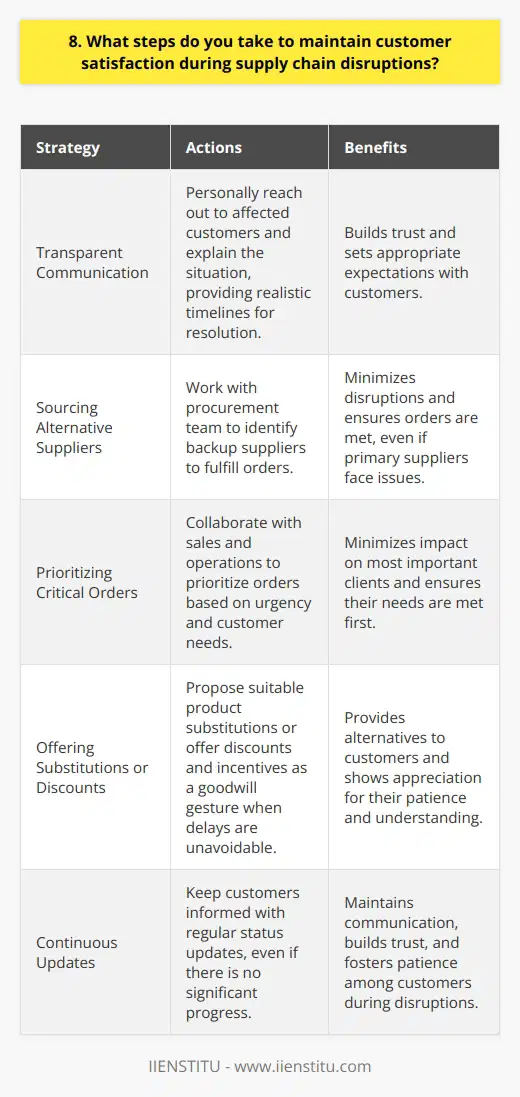
9. How do you collaborate with cross-functional teams to resolve supply chain issues?
When collaborating with cross-functional teams to resolve supply chain issues, I prioritize clear communication and active listening. I believe that understanding each team's unique perspective is crucial for finding effective solutions.
Building Strong Relationships
I make an effort to build rapport with colleagues from different departments. Grabbing coffee or having casual chats helps establish trust and facilitates smoother collaboration when issues arise.
Encouraging Open Dialogue
In meetings, I create an environment where everyone feels comfortable sharing ideas and concerns. I ask questions to gain a comprehensive understanding of the situation from all angles.
For example, when facing a inventory shortage last year, I organized a brainstorming session with procurement, logistics, and sales. By encouraging open dialogue, we uncovered a miscommunication that was causing the issue and implemented a new ordering process to prevent future shortages.
Leveraging Diverse Expertise
I recognize that each team brings valuable expertise to the table. I actively seek out insights from colleagues and incorporate their knowledge into problem-solving strategies.
Collaboration across departments is key to resolving supply chain issues efficiently. By fostering strong relationships, promoting open communication, and leveraging diverse perspectives, I work towards finding optimal solutions that benefit the entire organization.
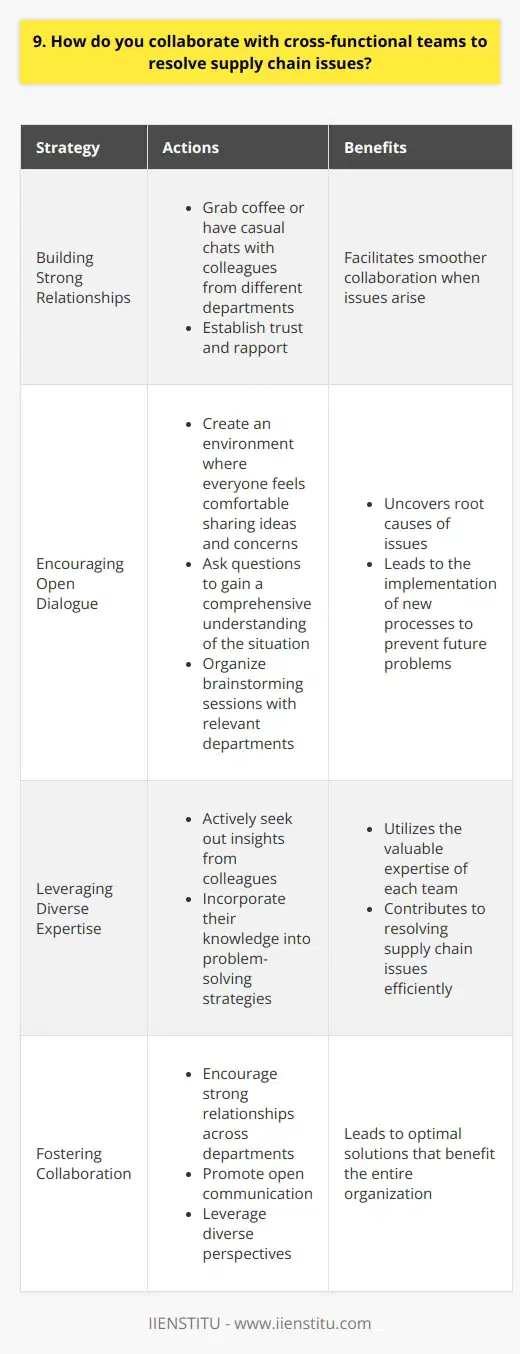
10. What tools or technologies do you utilize to enhance supply chain visibility?
As a supply chain professional, I utilize various tools and technologies to enhance supply chain visibility. One of the key solutions I rely on is a robust Enterprise Resource Planning (ERP) system.
Leveraging ERP for End-to-End Visibility
Our ERP system integrates data from multiple departments, providing a comprehensive view of our supply chain operations. It enables us to track inventory levels, monitor production schedules, and optimize resource allocation. With real-time data at our fingertips, we can make informed decisions and respond quickly to any potential disruptions.
Implementing Advanced Analytics
To further enhance visibility, I leverage advanced analytics tools that transform raw data into actionable insights. These tools help us identify trends, forecast demand, and predict potential bottlenecks. By proactively addressing issues before they escalate, we maintain a smooth and efficient supply chain flow.
Collaborating Through Cloud-Based Platforms
Collaboration is crucial for supply chain visibility. I utilize cloud-based platforms that facilitate seamless communication and data sharing with our suppliers and partners. These platforms provide a centralized repository for documents, enabling real-time collaboration and reducing the risk of information silos.
Embracing IoT and RFID Technology
I'm excited about the potential of Internet of Things (IoT) and Radio-Frequency Identification (RFID) technology in enhancing supply chain visibility. By attaching sensors and RFID tags to products and assets, we can track their movement and status in real-time. This granular level of visibility helps us optimize inventory management, reduce waste, and improve overall efficiency.
At the end of the day, my goal is to leverage these tools and technologies to create a transparent and agile supply chain. By having a clear view of our operations, we can make data-driven decisions, mitigate risks, and deliver exceptional value to our customers.
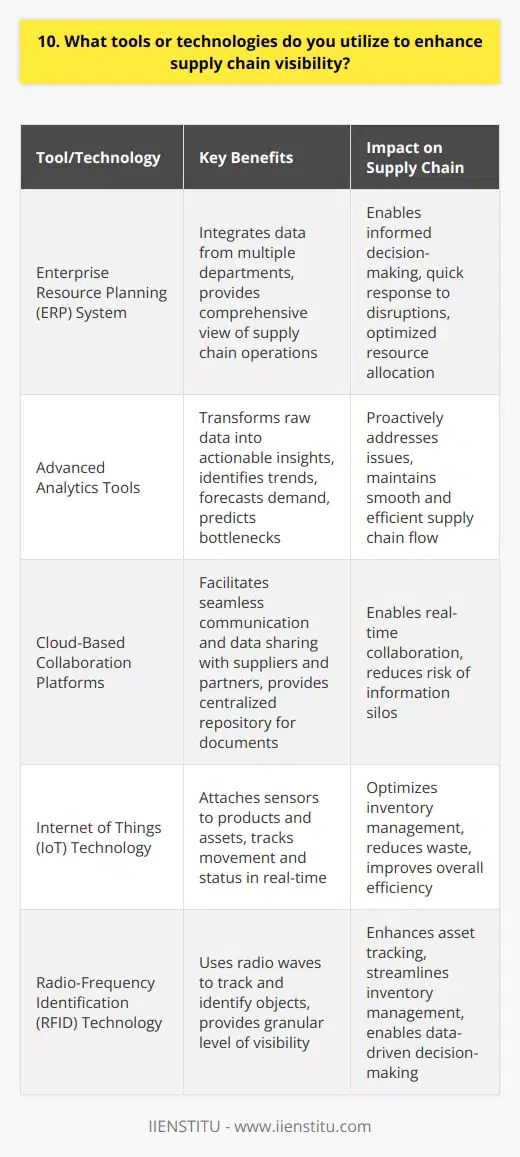
11. How do you ensure that your suppliers are aligned with your company's goals and values?
When selecting suppliers, I make sure they understand and share our company's vision, mission, and values. I clearly communicate our expectations and standards, and assess their alignment through conversations and research.
Establishing Clear Communication
I believe open and honest communication is key. I engage in regular discussions with suppliers about our goals, strategies, and ethical principles. This helps ensure we're on the same page from the start.
For example, when onboarding a new raw materials vendor last year, I scheduled multiple calls to thoroughly explain our sustainability initiatives. We worked together to brainstorm how they could support our efforts to reduce waste and emissions.
Conducting Thorough Assessments
I also conduct thorough assessments of potential suppliers before entering partnerships. This includes evaluating their business practices, reputation, and track record.
I look for concrete examples of how they've supported their clients' objectives in the past. Have they gone above and beyond to deliver results aligned with specific company values? If not, it may not be the right fit.
Ongoing Monitoring and Feedback
Alignment isn't a one-time checkbox - it requires ongoing attention. I regularly monitor suppliers' performance and provide feedback to keep us on track.
Through quarterly business reviews and frequent check-ins, I proactively identify and address any misalignments. We celebrate successes together and collaboratively tackle challenges.
By prioritizing communication, assessment, and continuous improvement, I've been able to build a network of suppliers who consistently advance our company's goals and uphold our values. It takes effort, but it's worth it to have partners who are truly invested in our mission.
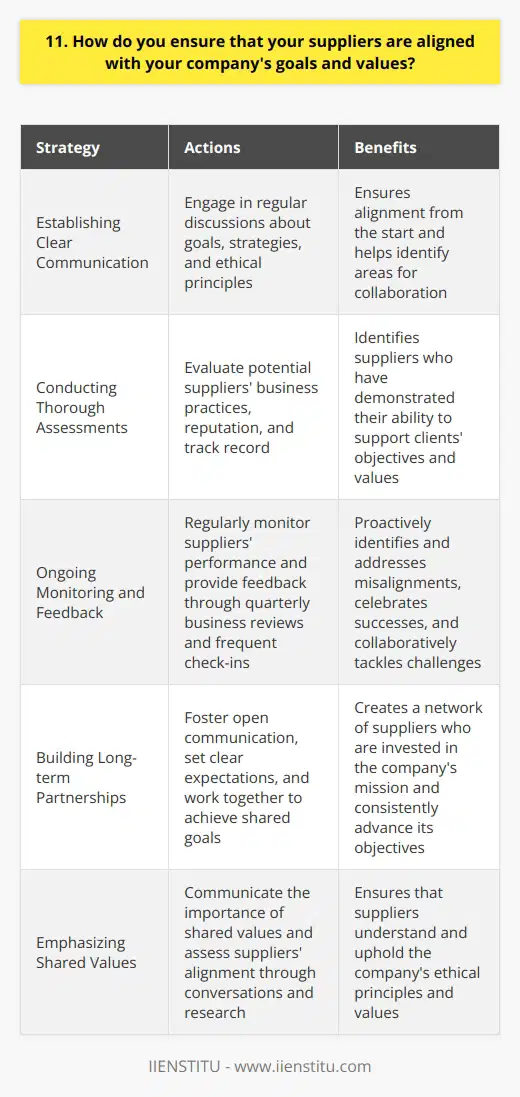
12. What experience do you have in managing inventory levels during supply chain disruptions?
Throughout my career, I've faced numerous supply chain disruptions that threatened inventory levels. I learned to stay agile and adaptable to maintain adequate stock.
Proactive Planning
I believe in proactively monitoring supply chain risks. I keep a close eye on market trends, weather patterns, and geopolitical events that could impact inventory flow.
By anticipating potential issues, I'm able to develop contingency plans. This has helped me minimize the impact of disruptions on several occasions.
Strong Supplier Relationships
I prioritize building trust and open communication with suppliers. When a hurricane struck a key supplier's region last year, our strong relationship allowed us to collaborate on alternative sourcing to prevent stockouts.
Inventory Optimization
I'm always looking for ways to optimize inventory levels. I analyze historical sales data, forecast demand, and determine ideal safety stock for each SKU.
By striking the right balance, I avoid tying up excess capital while still buffering against supply chain shocks. It's a constant fine-tuning process.
Leveraging Technology
I stay up-to-date on the latest supply chain technologies. Inventory management software, real-time tracking systems, and predictive analytics have been game-changers for me.
These tools provide the visibility and insights needed to make informed, timely decisions when disruptions hit. I used them to great effect to pivot inventory during the pandemic.
Cross-Functional Collaboration
Managing inventory during disruptions requires teamwork across the organization. I foster close partnerships with sales, marketing, finance, and logistics to align on priorities and solutions.
By breaking down silos, we can react more nimbly when challenges arise. I'm proud of how we've banded together to keep products flowing to customers during trying times.
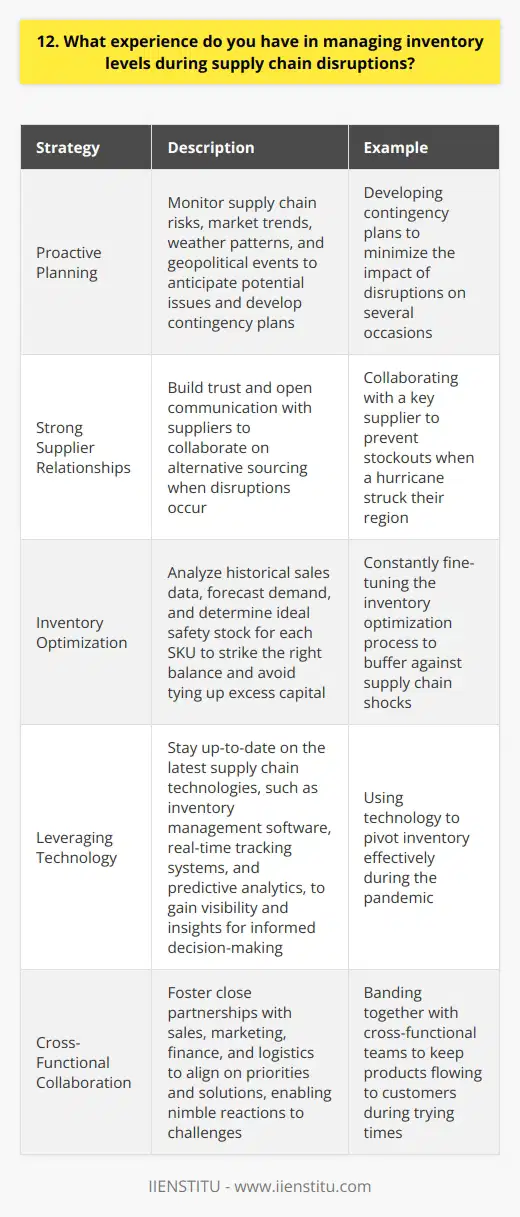
13. How do you evaluate and select reliable suppliers to minimize disruption risks?
When evaluating and selecting reliable suppliers, I follow a thorough process to minimize disruption risks. This approach has proven effective in my past roles and helps ensure a stable supply chain.
Research and Due Diligence
I start by researching potential suppliers, looking at their track record, financial stability, and reputation in the industry. Checking references from their current clients gives valuable insights into their reliability and performance.
Visiting supplier facilities in person, when possible, allows me to assess their operations, quality control measures, and working conditions firsthand. These visits help build trust and a personal connection with the supplier.
Qualifications and Certifications
I verify that suppliers hold relevant industry certifications, such as ISO 9001 for quality management or ISO 14001 for environmental management. These certifications demonstrate their commitment to meeting strict standards and continuous improvement.
Capacity and Scalability
Assessing a supplier's production capacity and ability to scale is crucial. I discuss their current capacity, lead times, and contingency plans for handling unexpected demand spikes or disruptions.
Contract Terms and Risk Mitigation
When negotiating contracts, I include clear performance metrics, quality requirements, and penalties for non-compliance. Building flexibility into the agreement, such as alternative sourcing options or safety stock requirements, helps mitigate potential disruptions.
Continuous Monitoring and Communication
Once a supplier is selected, I maintain regular communication and monitor their performance through key metrics and periodic audits. Building strong relationships and open lines of communication allows for quick resolution of any issues that arise.
By following this thorough evaluation process and fostering close partnerships with suppliers, I can minimize disruption risks and ensure a reliable supply chain that supports the company's goals.

14. What strategies do you use to build resilience in your supply chain?
As a supply chain professional, I employ several strategies to build resilience and mitigate potential disruptions:
Diversifying Supplier Base
I actively seek out and onboard multiple suppliers for critical components. This reduces dependency on single sources and provides flexibility when issues arise. Last year, when a key supplier faced production delays, our diverse network allowed us to quickly switch to an alternative without impacting customer deliveries.
Building Strong Supplier Relationships
I prioritize open communication and collaboration with suppliers. Regular check-ins help identify potential risks early. During the pandemic, close coordination with our logistics partners enabled us to adapt shipping methods and maintain supply continuity despite port congestion.
Implementing Risk Monitoring and Contingency Planning
I leverage technology to monitor supply chain risks in real-time. Advanced analytics flag potential disruptions, allowing proactive mitigation. We also develop robust contingency plans for various scenarios. When a natural disaster struck a supplier's region, our pre-established backup plan minimized the impact on our operations.
Emphasizing Agility and Flexibility
I foster a culture of agility within my team. Cross-training employees and designing adaptable processes enable quick adjustments when needed. Last quarter, when demand suddenly spiked for a product, our flexible approach allowed us to ramp up production and meet customer needs without sacrificing quality.
Building supply chain resilience is an ongoing journey. By staying vigilant, adaptable, and focused on continuous improvement, I strive to ensure our supply chain remains robust and responsive in the face of any challenge.
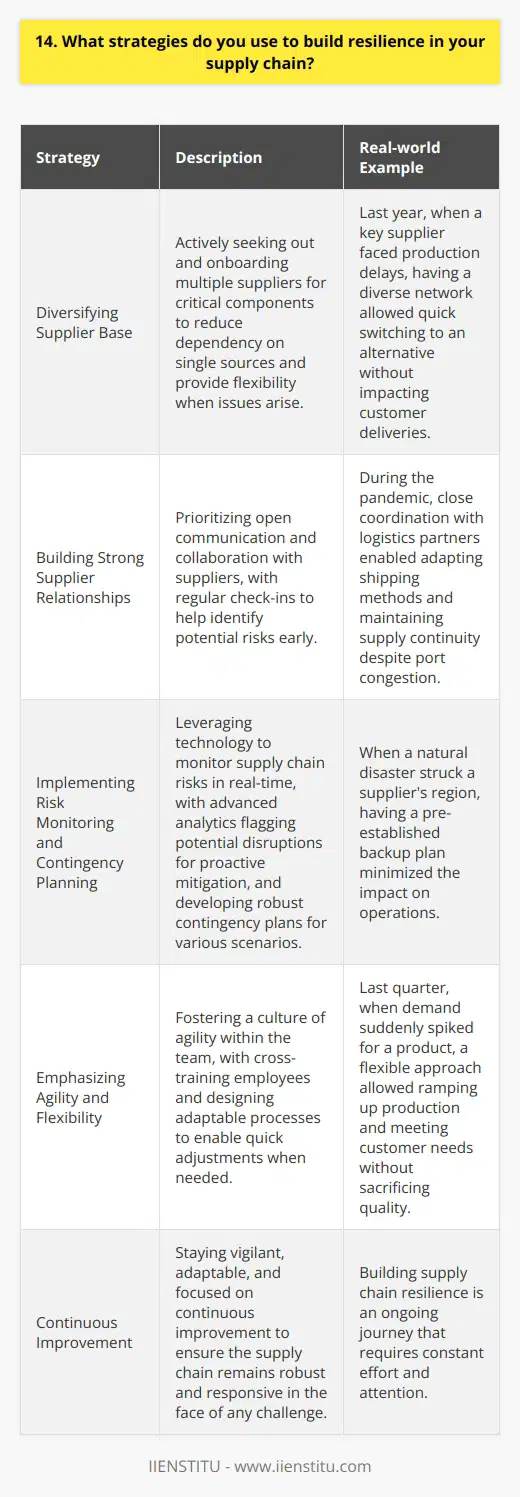
15. How do you stay informed about industry trends and best practices in supply chain management?
I stay informed about industry trends and best practices in supply chain management in several ways. First, I regularly read industry publications and blogs to keep up with the latest news and developments. Some of my favorite sources include Supply Chain Dive, Logistics Management, and the Harvard Business Review.
Attending Conferences and Webinars
I also make an effort to attend industry conferences and webinars whenever possible. These events provide valuable opportunities to learn from experts, network with peers, and gain exposure to new ideas and technologies. Last year, I had the chance to attend the CSCMP Edge conference, where I learned about emerging trends like blockchain and artificial intelligence in supply chain management.
Participating in Professional Organizations
Another way I stay informed is by participating in professional organizations like APICS and the Institute for Supply Management. These groups offer a wealth of resources, including training programs, certification courses, and local chapter meetings. I've found that engaging with other supply chain professionals through these organizations has helped me expand my knowledge and stay up-to-date on best practices.
Collaborating with Colleagues
Finally, I believe that collaborating with colleagues and learning from their experiences is crucial. I make a point to connect with co-workers from different departments and backgrounds to gain diverse perspectives on supply chain challenges and opportunities. Just last week, I had an enlightening conversation with a colleague from our logistics team about how we could optimize our transportation network to reduce costs and improve delivery times.
Staying informed about industry trends and best practices is an ongoing process, but by leveraging these strategies, I feel confident in my ability to navigate the ever-changing landscape of supply chain management.
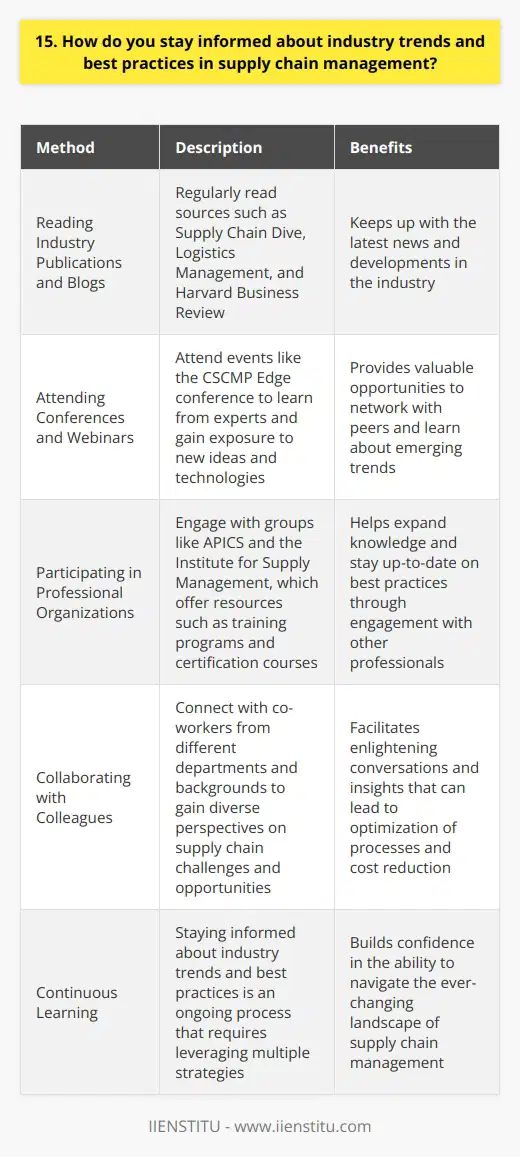
16. What experience do you have in managing logistics and transportation during disruptions?
Throughout my career, I have successfully managed logistics and transportation during various disruptions. I stay calm under pressure and quickly adapt to changing circumstances.
Effective Communication
I maintain open lines of communication with all stakeholders. This allows me to stay informed and coordinate effective responses. I clearly convey updates and instructions to team members, ensuring everyone is on the same page.
Example: Port Strike
During a port strike, I proactively reached out to carriers and negotiated alternative routing. By keeping clients informed, we minimized delays and kept their supply chains moving.
Contingency Planning
I believe in being proactive rather than reactive. I develop robust contingency plans that can be implemented at a moment's notice. By anticipating potential disruptions, we can respond swiftly and minimize impacts.
Example: Severe Weather Event
Before hurricane season, I worked with my team to create detailed contingency plans. When a storm hit, we quickly enacted these plans. We rerouted shipments and secured alternative warehousing to protect our clients' cargo.
Creative Problem-Solving
I thrive on finding creative solutions to complex logistics challenges. I think outside the box and explore unconventional approaches. By being resourceful and adaptable, I can keep goods flowing despite disruptions.
Example: Factory Shutdown
When a key supplier's factory unexpectedly shut down, I sourced alternative manufacturers. I expedited production and arranged air freight to make up for lost time. My quick thinking kept the project on track.

17. How do you foster a culture of continuous improvement in your supply chain operations?
Fostering a culture of continuous improvement in supply chain operations is crucial for staying competitive. I believe that it starts with empowering employees and encouraging open communication. By providing training and development opportunities, team members can acquire new skills and knowledge to drive improvements.
Encourage Innovation and Experimentation
I always encourage my team to think outside the box and experiment with new ideas. Even if an idea doesn't work out, we learn valuable lessons and keep pushing forward. Celebrating successes, no matter how small, helps to maintain momentum and motivation.
Leveraging Technology
Technology plays a vital role in enabling continuous improvement. By investing in the right tools and systems, we can streamline processes, reduce waste, and improve efficiency. I'm always on the lookout for new technologies that can give us a competitive edge.
Collaborating with Suppliers and Partners
Building strong relationships with suppliers and partners is key to driving improvements throughout the supply chain. By working closely together, sharing knowledge and best practices, we can identify areas for improvement and implement solutions that benefit everyone involved.
Measuring and Analyzing Performance
To continuously improve, we need to measure and analyze our performance regularly. By tracking key metrics and conducting root cause analysis, we can identify bottlenecks, inefficiencies, and opportunities for improvement. This data-driven approach helps us make informed decisions and prioritize initiatives that deliver the greatest impact.
At the end of the day, fostering a culture of continuous improvement is about creating an environment where everyone is encouraged to contribute ideas, take risks, and strive for excellence. It's a never-ending journey, but one that I'm passionate about and committed to pursuing every day.
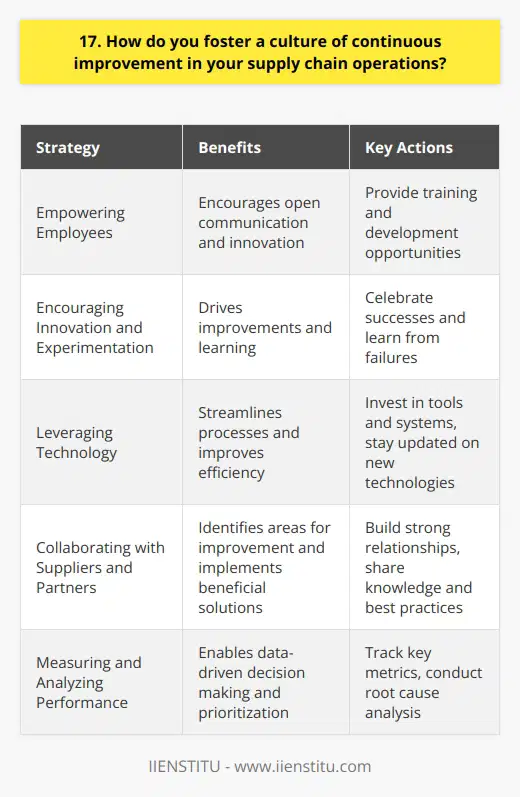
18. What steps do you take to ensure the security and integrity of your supply chain?
When it comes to ensuring the security and integrity of our supply chain, I take a proactive approach. I believe in building strong relationships with trusted suppliers who share our commitment to quality and transparency.
Rigorous Screening Process
Before onboarding any new supplier, I conduct thorough background checks and assess their track record. I look for red flags such as past legal issues or inconsistencies in their business practices.
Regular Audits and Inspections
To maintain ongoing oversight, I schedule regular audits of our suppliers' facilities and processes. During these visits, I verify that they are adhering to our strict standards for safety, ethics, and quality control.
Technology-Driven Monitoring
I leverage cutting-edge technology to monitor our supply chain in real-time. From GPS tracking of shipments to blockchain-based record keeping, these tools provide invaluable visibility and accountability.
Collaborative Problem-Solving
If issues do arise, I believe in working closely with our suppliers to find mutually beneficial solutions. Open communication and a spirit of partnership are key to overcoming challenges and strengthening our supply chain.
Continuous Improvement
Finally, I'm always looking for ways to optimize and enhance our supply chain security measures. Whether it's exploring new technologies or refining our processes, I'm committed to staying ahead of potential threats.
At the end of the day, protecting the integrity of our supply chain is not just a job responsibility for me - it's a personal mission. I take great pride in knowing that our products are sourced ethically and delivered safely to our valued customers.
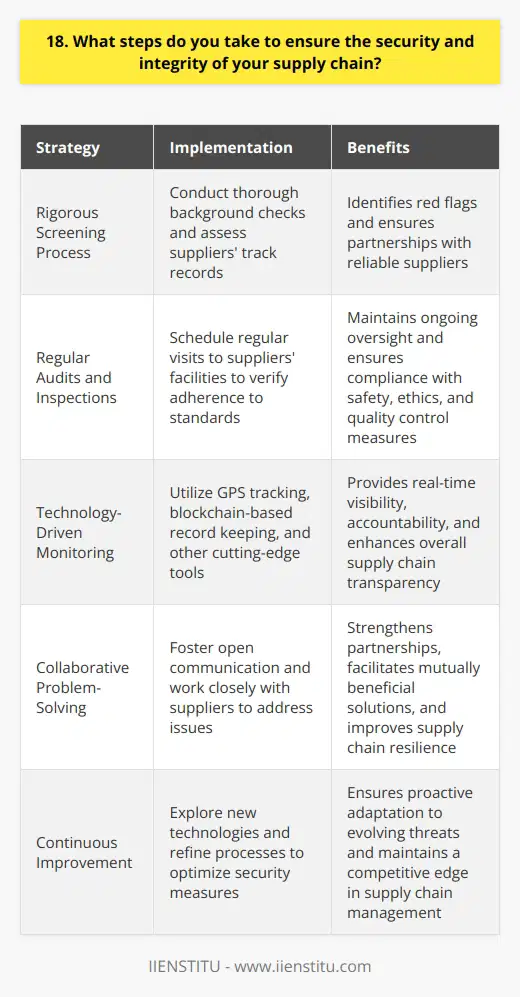
19. How do you manage relationships with multiple suppliers across different regions?
I have extensive experience managing relationships with suppliers across different regions. Effective communication is key to building strong partnerships. I maintain open lines of communication through regular calls, emails, and video conferences. This helps me stay informed about their operations, products, and any potential issues.
Building Trust and Rapport
I believe in fostering a culture of trust and transparency with my suppliers. I make an effort to understand their unique challenges and work collaboratively to find solutions. By treating them as valued partners, I can build long-lasting relationships that benefit both parties.
Streamlining Processes
To manage multiple suppliers efficiently, I implement standardized processes and systems. This includes using supplier portals, automated ordering, and inventory management tools. By streamlining these processes, I can reduce errors, improve order accuracy, and save time.
Continuous Improvement
I'm always looking for ways to optimize our supply chain and improve supplier performance. I regularly review metrics like on-time delivery, quality, and cost. If issues arise, I work closely with the supplier to develop improvement plans and track progress. By continuously improving, we can drive better results for the company.
In my previous role, I successfully managed a diverse network of over 20 suppliers across three continents. Through proactive relationship management and process optimization, I reduced lead times by 15% and improved overall supplier performance. I'm confident I can bring the same level of expertise and drive similar results for your organization.

20. What experience do you have in implementing sustainable supply chain practices?
Throughout my career, I have gained valuable experience in implementing sustainable supply chain practices. I strongly believe that sustainability is not just a trend but a necessity for businesses to thrive in the long run.
Collaborating with Suppliers
I have worked closely with suppliers to ensure they adhere to eco-friendly practices. This involved conducting regular audits and providing training to help them meet our sustainability standards. Through open communication and partnership, we were able to reduce waste and minimize the environmental impact of our supply chain.
Implementing Recycling Programs
One of my proudest achievements was implementing a comprehensive recycling program across our supply chain. We worked with suppliers to use recyclable packaging materials and set up collection points for used products. This initiative not only reduced waste but also saved costs and improved our brand image among environmentally conscious consumers.
Optimizing Transportation
I have also focused on optimizing transportation to reduce carbon emissions. By consolidating shipments, using fuel-efficient vehicles, and partnering with logistics providers who prioritize sustainability, we were able to significantly reduce our transportation-related environmental footprint.
I am passionate about finding innovative solutions to make supply chains more sustainable. I believe that by continuously improving our practices and collaborating with stakeholders, we can create a more resilient and responsible business ecosystem.
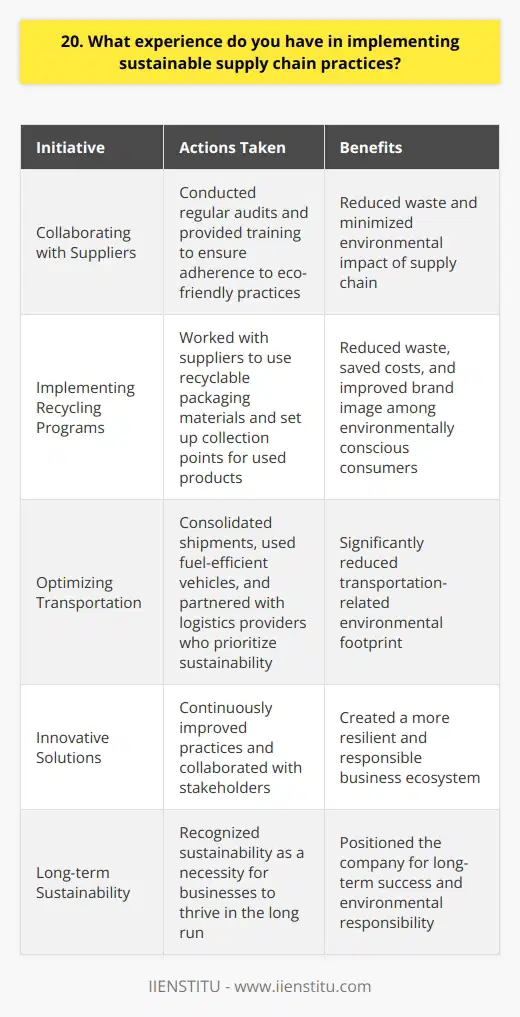
21. How do you handle unexpected spikes in demand that strain your supply chain?
When faced with unexpected spikes in demand that strain the supply chain, I take a proactive approach. First, I analyze the situation to identify the root cause of the issue. This helps me develop targeted solutions.
Collaborating with Suppliers
I reach out to our suppliers to discuss the increased demand and explore ways to boost production. By maintaining open lines of communication, we can often find creative solutions to meet the challenge. I also work to diversify our supplier base to reduce reliance on any single provider.
Optimizing Inventory Management
To handle spikes in demand, I review our inventory management practices. I look for opportunities to streamline processes and improve efficiency. This might involve adjusting reorder points, implementing just-in-time delivery, or using technology to better track stock levels. By optimizing inventory management, we can respond more nimbly to fluctuations in demand.
Communicating with Customers
When supply chain issues impact our ability to meet customer needs, I believe in transparent communication. I reach out to affected customers to explain the situation and provide realistic timelines for resolution. By setting clear expectations and providing regular updates, we can maintain trust even in challenging circumstances.
Ultimately, handling unexpected spikes in demand requires a combination of strategic planning, collaboration, and adaptability. By taking a proactive approach and leveraging relationships with suppliers and customers, I work to minimize disruptions and find solutions to keep the business moving forward.
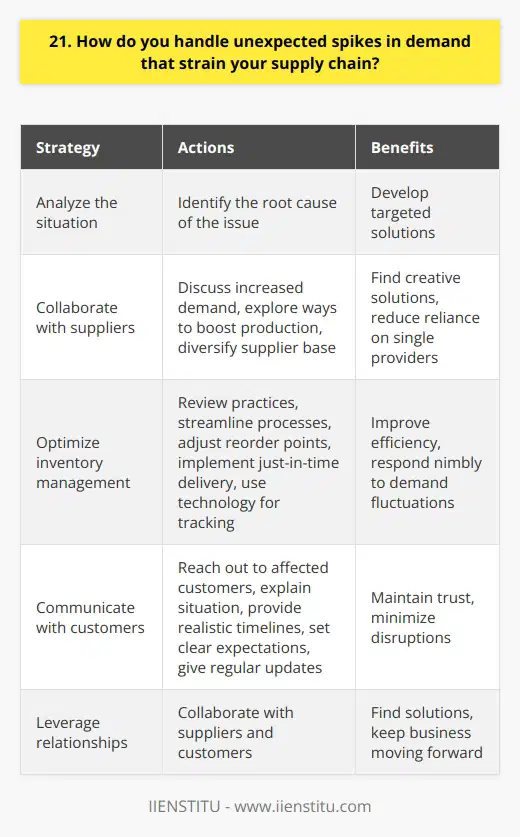
22. What strategies do you use to negotiate with suppliers during a supply chain crisis?
When negotiating with suppliers during a supply chain crisis, I employ several strategies to ensure the best outcome for my company:
Maintain open communication
I keep lines of communication open with suppliers, fostering a relationship built on trust and transparency. This allows for productive discussions and problem-solving.
Prioritize essential products
I work with suppliers to identify the most critical products and prioritize their delivery. This helps keep our operations running smoothly despite the crisis.
Explore alternative solutions
I encourage suppliers to propose creative solutions, such as sourcing from different locations or using alternative materials. Being open to new ideas can lead to innovative resolutions.
Offer flexibility in payment terms
I understand that suppliers may also be facing financial challenges during a crisis. Offering flexible payment terms can help maintain a strong partnership while navigating difficult times.
Collaborate with other companies
I reach out to other companies in my network to explore the possibility of sharing resources or collaborating on orders. This can help secure supplies and reduce costs for all parties involved.
By employing these strategies, I have successfully navigated supply chain crises in the past, ensuring that my company has the resources it needs to continue operating effectively. I believe that open communication, creativity, and a willingness to collaborate are key to finding solutions in challenging times.
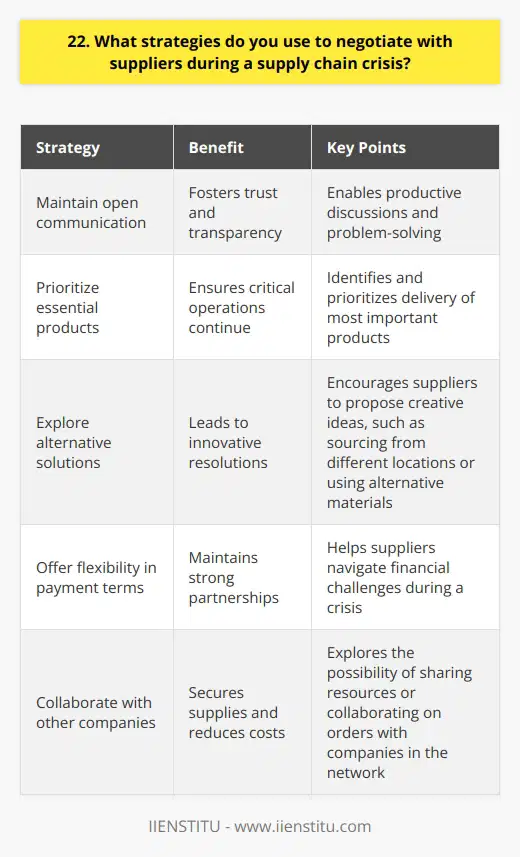
23. How do you ensure that your supply chain is compliant with relevant regulations and standards?
At our company, we take supply chain compliance seriously. We have implemented a robust system to ensure adherence to regulations and standards:
Comprehensive Compliance Policies
We have developed detailed compliance policies that cover all aspects of our supply chain operations. These policies are regularly reviewed and updated to keep pace with changing regulations.
Rigorous Supplier Screening
Before onboarding any new supplier, we conduct thorough due diligence to verify their compliance with relevant standards. This includes site visits, document reviews, and background checks.
Ongoing Monitoring and Audits
We continuously monitor our suppliers' compliance through regular audits and assessments. Any non-compliance issues are promptly addressed and corrective actions are implemented.
Employee Training and Awareness
All our employees involved in supply chain management receive comprehensive training on compliance requirements. We foster a culture of compliance awareness throughout the organization.
Technology-Enabled Compliance Tracking
We leverage advanced technology solutions to track and monitor compliance across our supply chain network. This includes real-time monitoring, automated alerts, and data analytics.
I remember an instance where our compliance monitoring system flagged a potential issue with a supplier's labor practices. We immediately investigated and worked with the supplier to rectify the situation, ensuring full compliance with labor standards.
Maintaining a compliant supply chain is not just a regulatory obligation for us; it's a core value. We believe that by upholding the highest standards of compliance, we can build trust with our customers, partners, and stakeholders. It's an ongoing commitment that requires vigilance, proactiveness, and a willingness to continuously improve.
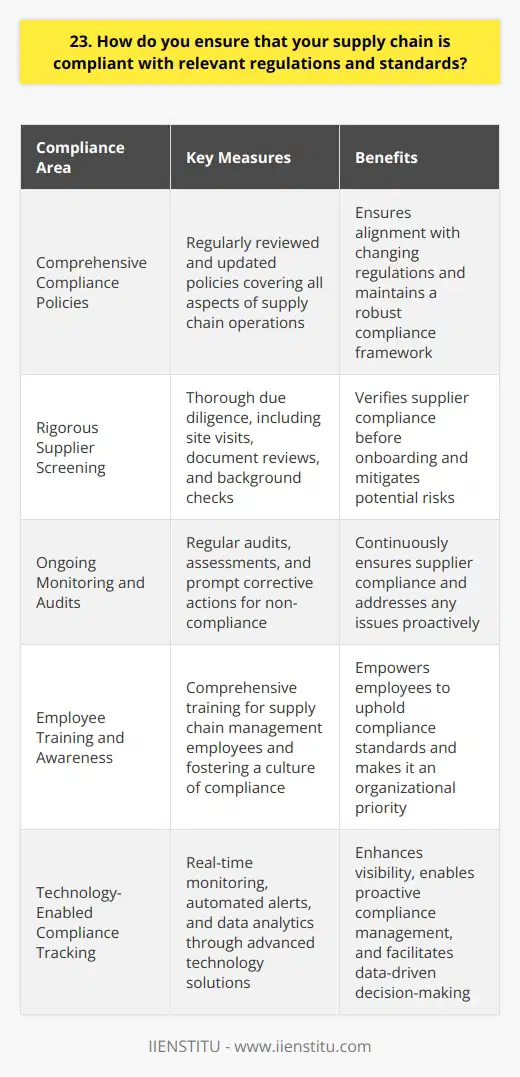
24. What experience do you have in managing supply chain costs during disruptions?
Throughout my career, I've gained valuable experience in managing supply chain costs during disruptions. I've developed a keen understanding of the importance of proactive planning and swift adaptability in the face of unexpected challenges.
Implementing Contingency Plans
One of the key strategies I've employed is the development and implementation of robust contingency plans. By identifying potential risks and creating alternative sourcing options, I've been able to minimize the impact of disruptions on our supply chain costs. These plans have proven invaluable during times of crisis, allowing us to maintain a steady flow of materials and products while keeping expenses under control.
Leveraging Technology
I've also leveraged technology to enhance visibility and optimize our supply chain processes. By utilizing advanced analytics tools and real-time monitoring systems, I've been able to quickly identify bottlenecks and inefficiencies, enabling me to make data-driven decisions to mitigate risks and reduce costs. This proactive approach has helped me stay ahead of potential disruptions and ensure the smooth functioning of our supply chain operations.
Building Strong Supplier Relationships
Another critical aspect of managing supply chain costs during disruptions is building strong relationships with suppliers. I've invested time and effort in fostering open communication, collaboration, and trust with our key suppliers. By establishing these partnerships, I've been able to negotiate flexible terms, secure alternative sourcing options, and implement joint risk mitigation strategies. These strong relationships have been instrumental in navigating through challenging times and minimizing the financial impact of disruptions.
In summary, my experience in managing supply chain costs during disruptions encompasses proactive planning, leveraging technology, and building strong supplier relationships. Through these strategies, I've successfully navigated through various challenges and delivered cost-effective solutions to ensure the resilience and competitiveness of our supply chain operations.

25. How do you foster innovation and creativity in your supply chain management approach?
I believe that fostering innovation and creativity in supply chain management is essential for staying competitive. In my approach, I prioritize open communication and collaboration among team members. By encouraging everyone to share their ideas and perspectives, we can generate fresh solutions to challenges.
Embracing Technology
I'm always on the lookout for new technologies that can streamline our processes and improve efficiency. Whether it's implementing a cutting-edge inventory management system or exploring the potential of blockchain for enhancing transparency, I believe in staying at the forefront of technological advancements.
Real-World Example
In my previous role, I spearheaded the implementation of a cloud-based transportation management system. By leveraging this technology, we were able to optimize our routes, reduce fuel consumption, and improve delivery times. It was a game-changer for our supply chain operations.
Encouraging Continuous Learning
I'm a strong proponent of continuous learning and professional development. I actively encourage my team members to attend industry conferences, workshops, and training sessions. By staying up-to-date with the latest trends and best practices, we can bring fresh perspectives and innovative ideas to the table.
Personal Growth Story
Early in my career, I had the opportunity to attend a supply chain innovation summit. It opened my eyes to the vast possibilities for creativity in this field. Since then, I've made it a priority to foster a culture of continuous learning within my teams.
Collaborating with Stakeholders
I believe that true innovation happens when we break down silos and collaborate with stakeholders across the supply chain. By engaging with suppliers, customers, and internal departments, we can identify opportunities for improvement and develop creative solutions that benefit everyone.
In summary, my approach to fostering innovation and creativity in supply chain management revolves around open communication, embracing technology, encouraging continuous learning, and collaborating with stakeholders. By creating an environment that values fresh perspectives and outside-the-box thinking, we can drive meaningful change and stay ahead of the curve.
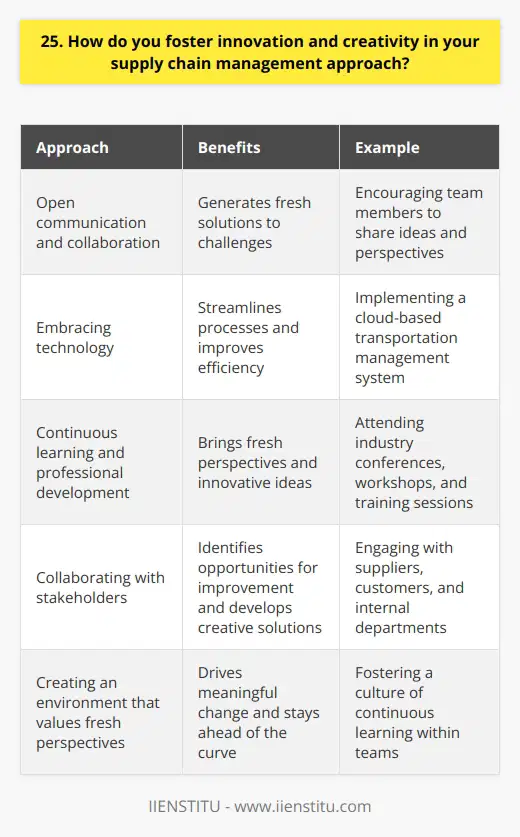
26. What steps do you take to maintain the quality of products during supply chain disruptions?
As a supply chain manager, I take several steps to maintain product quality during disruptions. First and foremost, I focus on building strong relationships with our suppliers. By establishing open lines of communication and fostering trust, we can work together to navigate challenges.
Diversifying Suppliers
I believe in diversifying our supplier base to reduce the risk of disruptions. By sourcing from multiple suppliers in different geographic locations, we can minimize the impact of localized issues. This strategy has proven effective in ensuring a steady flow of high-quality materials.
Implementing Quality Control Measures
Throughout the supply chain, I implement rigorous quality control measures. This includes conducting regular audits of our suppliers' facilities and processes. By personally visiting these sites, I can assess their adherence to our quality standards and address any concerns promptly.
Leveraging Technology
I leverage technology to enhance supply chain visibility and transparency. By utilizing real-time tracking systems and data analytics, I can monitor the movement of goods and identify potential issues early on. This allows us to take proactive steps to maintain product quality and prevent disruptions.
Collaborating with Cross-Functional Teams
Maintaining product quality requires collaboration across various functions within the organization. I actively engage with our R&D, manufacturing, and quality assurance teams to ensure that our products meet the highest standards. By fostering a culture of open communication and teamwork, we can quickly adapt to changes in the supply chain.
Ultimately, my approach to maintaining product quality during supply chain disruptions is rooted in proactivity, adaptability, and collaboration. By staying vigilant, building strong relationships, and leveraging technology, I strive to minimize the impact of disruptions and deliver the best possible products to our customers.
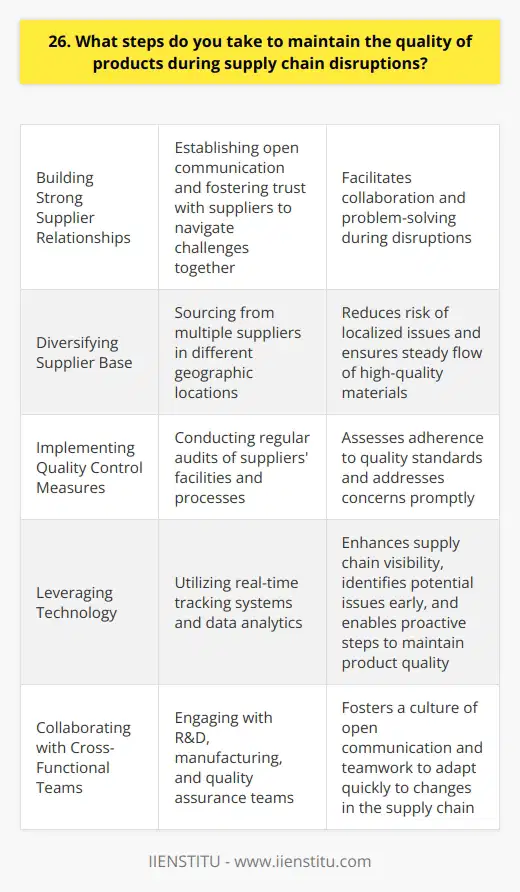
27. How do you handle the challenges of managing a global supply chain?
Managing a global supply chain is a complex task that requires a multifaceted approach. I believe in building strong relationships with suppliers, staying informed about geopolitical and economic factors, and being proactive in risk management.
Building Strong Supplier Relationships
I've found that open communication and collaboration with suppliers is key. By fostering trust and understanding, we can work together to overcome challenges and ensure a reliable supply chain.
For example, at my previous company, I regularly visited our key suppliers around the world to strengthen partnerships. This allowed us to troubleshoot issues more effectively and implement improvements together.
Staying Informed on Global Factors
To manage a global supply chain well, it's crucial to stay up-to-date on geopolitical events, economic trends, and other factors that could impact operations. I make a point to follow relevant news sources and industry publications.
In my last role, monitoring tariff changes and trade tensions helped me anticipate disruptions and adjust our sourcing strategy proactively. Staying informed allowed us to minimize negative impacts.
Proactive Risk Mitigation
I believe in taking a proactive approach to identifying and mitigating supply chain risks. This involves thoroughly assessing vendors, diversifying suppliers, and developing contingency plans.
At a previous job, I led an initiative to map out our entire supply network and pinpoint potential vulnerabilities. We then worked cross-functionally to strengthen weak points and create backup plans, improving overall resilience.
While managing a global supply chain will always involve challenges, I've found that building strong relationships, staying vigilant of global factors, and proactively addressing risks are effective strategies to overcoming hurdles. I'm confident that my experience and approach would enable me to skillfully handle global supply chain management at your company.
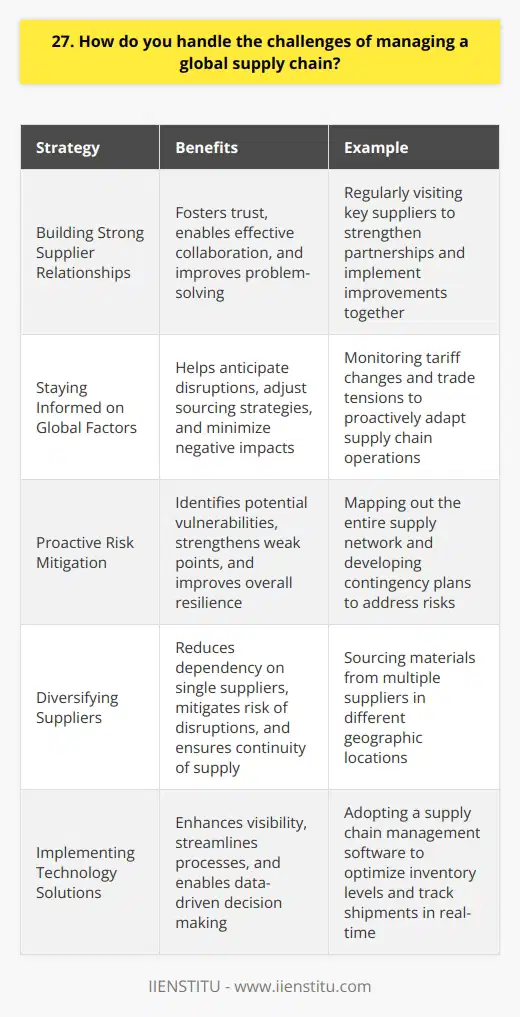
28. What experience do you have in implementing automation and digitization in supply chain processes?
Throughout my career, I have gained valuable experience in implementing automation and digitization in supply chain processes. I am passionate about leveraging technology to streamline operations and drive efficiency.
Automation Experience
In my previous role, I spearheaded a project to automate our inventory management system. By implementing intelligent algorithms and real-time tracking, we reduced manual data entry by 80% and improved inventory accuracy to 99%. This automation initiative saved our team countless hours and allowed us to focus on strategic tasks.
Digitization Initiatives
I have also been actively involved in digitizing our supply chain processes. I led the implementation of a cloud-based platform that centralized our supplier communication and order management. This digital transformation enhanced collaboration, reduced paper-based processes, and provided real-time visibility into our supply chain. As a result, we experienced a 25% reduction in lead times and improved supplier relationships.
Continuous Improvement
I am a firm believer in continuous improvement and staying up-to-date with the latest technologies. I regularly attend industry conferences and workshops to learn about emerging trends in supply chain automation and digitization. I have also completed certifications in supply chain management and lean six sigma, which have equipped me with the tools to identify opportunities for process optimization.
In summary, my experience in automation and digitization has yielded tangible results, including increased efficiency, cost savings, and improved supply chain visibility. I am excited about the opportunity to bring my expertise to your organization and contribute to the digital transformation of your supply chain processes.
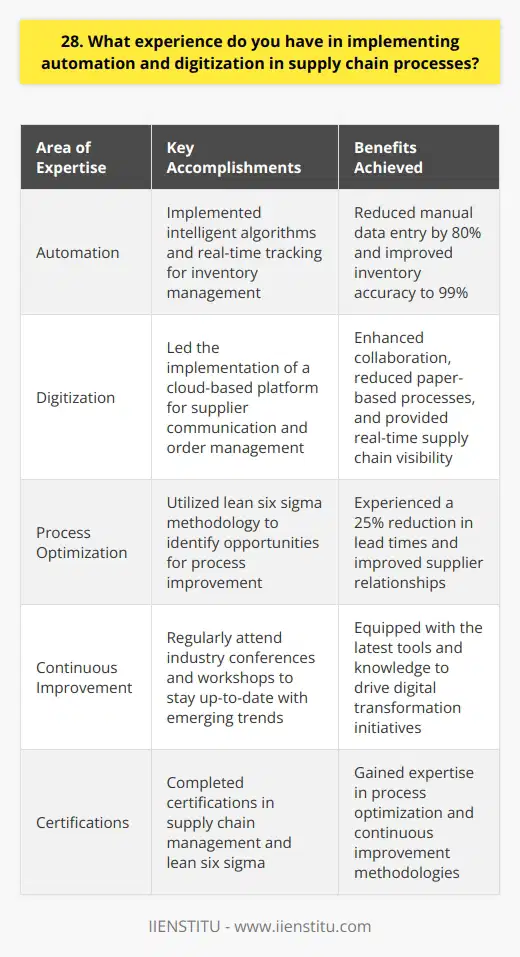
29. How do you ensure effective reverse logistics and product returns management?
To ensure effective reverse logistics and product returns management, I focus on several key areas:
Establishing Clear Policies
I work with the team to develop clear, customer-friendly return policies that are easy to understand and follow. This helps set expectations and streamline the returns process for both customers and our internal staff.
Efficient Processing
I strive to make the returns process as efficient as possible. This involves creating simple, intuitive procedures for customers to initiate returns and providing pre-printed return labels when feasible. Once items are received, I prioritize quick inspection, sorting, and dispositioning to minimize processing times.
Data Analysis
I regularly analyze return data to identify trends, problem products, or common customer issues. By staying on top of this information, I can recommend improvements to product design, quality, or descriptions to reduce return rates over time. Data insights also help optimize inventory planning.
Collaboration
Effective reverse logistics requires close collaboration with multiple departments. I maintain open lines of communication with sales, customer service, warehousing, and finance teams to ensure everyone is aligned. Regular cross-functional meetings help surface issues and improvement opportunities.
Continuous Improvement
I'm always looking for ways to enhance the returns management process. Whether it's implementing new technology to automate tasks, renegotiating carrier contracts, or finding new channels to liquidate returned inventory, I enjoy the challenge of continuous improvement. My goal is to turn the returns process into a competitive advantage for the company while maintaining high levels of customer satisfaction.
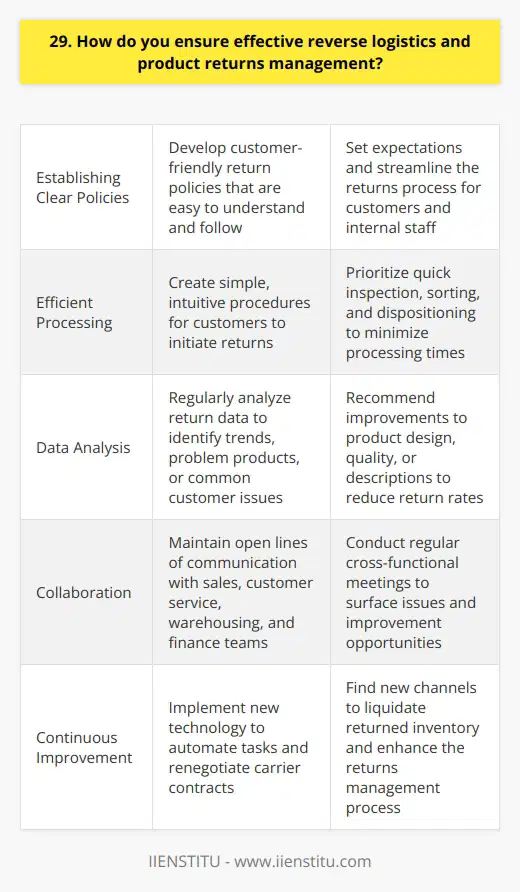
30. What strategies do you use to build long-term, mutually beneficial relationships with suppliers?
I believe in fostering strong, long-lasting relationships with suppliers based on trust, communication, and mutual benefit. I always strive to be transparent and honest in my dealings with suppliers.
Building Trust and Rapport
I take the time to get to know my suppliers on a personal level. I'll often meet with them face-to-face, when possible, to put a human touch on the relationship. Sharing stories and learning about their business helps establish a genuine connection.
Consistency and reliability are key. I make sure to follow through on my commitments and pay invoices promptly. When issues arise, as they inevitably do, I address them head-on with open, constructive dialogue. Suppliers appreciate knowing they can count on me.
Seeking Win-Win Outcomes
I view my supplier relationships as partnerships rather than purely transactional. I aim to understand their goals, challenges and pain points. By aligning our objectives, we can uncover mutually advantageous opportunities.
For example, I might collaborate with a supplier on forecasting and production planning to optimize their efficiency and secure better pricing. Or I'll connect them with other potential customers in my network. When my suppliers succeed, I succeed.
Continuous Improvement and Innovation
I regularly solicit feedback from my suppliers on how I can be a better customer. I welcome their ideas and insights. Together, we brainstorm ways to streamline processes, reduce waste, and drive innovation in products and services.
I stay attuned to industry trends and share relevant information with my suppliers. By positioning ourselves at the forefront of the market, we can proactively adapt and seize emerging opportunities.


